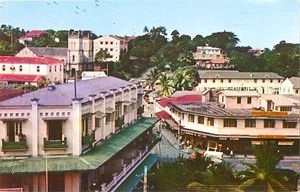Fiji
 From Conservapedia
From Conservapedia | Matanitu ko Viti Fiji
| |
|---|---|
 |
 |
| Flag | Coat of Arms |
| Capital | Suva |
| Government | Parliamentary Republic |
| Language | [[Fijian, English, Fiji Hindi]] (official) |
| President | George Konrote |
| Prime minister | Frank Bainimarama |
| Area | 7,056 sq. miles |
| Population | 900,000 (2020) |
| Currency | Fijian Dollar |

Fiji, officially the Fijian Republic, is an island group 5500 miles south west of the continental United States (3100 miles from Hawaii). It is located north of New Zealand and west of Tonga. The largest islands are Viti Levu with the capital Suva on the east coast and international airport at Nadi on the west coast, and Vanua Levu. Outlying islands include Taveuni and Kadavu, both world-famous SCUBA-diving destinations.
History[edit]
The earliest settlement of Fiji can be attributed to the Lapita people, seen as the ancestors of the current Fijian. Their settlement in the Natadola area of southwest Viti Levu Island can be dated to 1260 B.C. These aborigines are genetically related to Malay and Polynesians, and linguists classify their language as Austronesian.[1]
Fiji is the source of many of the tales of South Pacific cannibalism, the consumption of enemy tribesmen captured in the internecine warfare being a major social activity, and other victims being used as foundations of buildings and living rollers to launch war canoes. The arrival of (initially Catholic) missionaries and conversion of the islanders to Christianity brought an end to cannibalism in the islands.

Religion in Fiji is varied but Christianity is the most dominant religion, accounting for almost 80% of the indigenous Fijians, most of whom are members of the Methodist Church. The Anglican and Catholic Churches are also prominent. Apart from Christianity, Hinduism has a strong influence amongst the Indian population.[2]
Fiji gained independence from Britain in 1970. Almost two-fifths of the population is of Indian descent, whose ancestors were brought to Fiji to work on sugar plantations in the late 19th and early 20th centuries; these live almost entirely on the two main islands of the group. Conflict of interests, superficially between the indigenous Fijian and Indo-Fijian populations, but actually between rural and reactionary, and urban and progressive factions, has led to a number of non-violent, but highly disruptive political coups since independence.
References[edit]
- ↑ http://www.usp.ac.fj/index.php?id=2531&tx_ttnews[tt_news]=71&tx_ttnews[backPid]=331&cHash=b011137648 <- Paste this URL in your browser.
- ↑ http://www.mapsofworld.com/fiji/culture/religion.html
Categories: [Oceanian Countries] [Archipelagos] [Christian-Majority Countries]
↧ Download as ZWI file | Last modified: 02/23/2023 15:46:15 | 113 views
☰ Source: https://www.conservapedia.com/Fiji | License: CC BY-SA 3.0
 ZWI signed:
ZWI signed: KSF
KSF